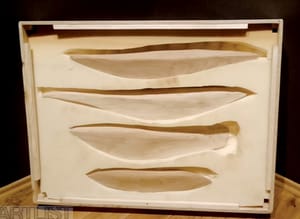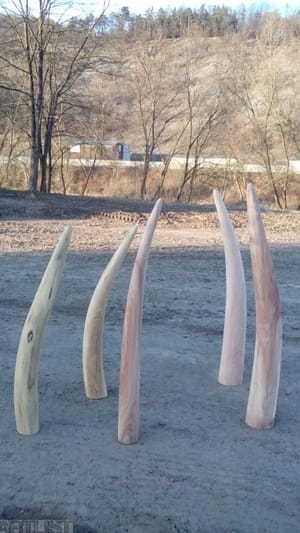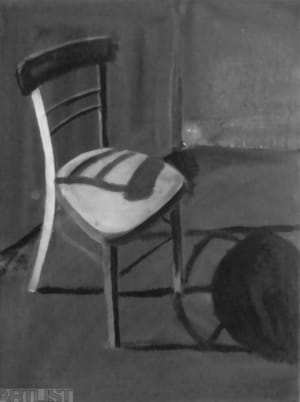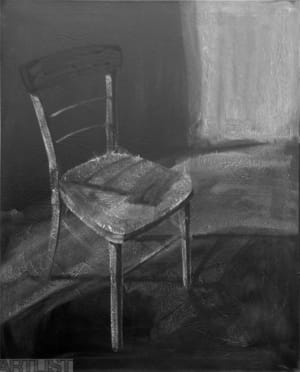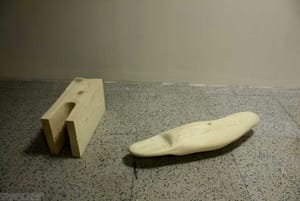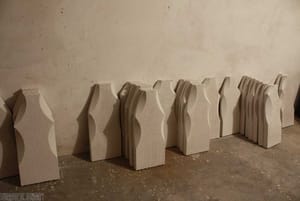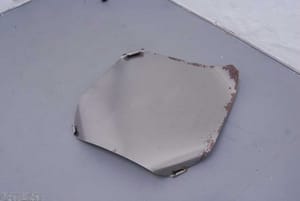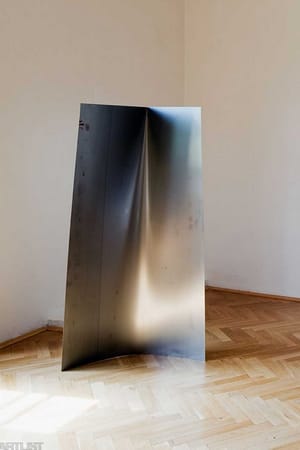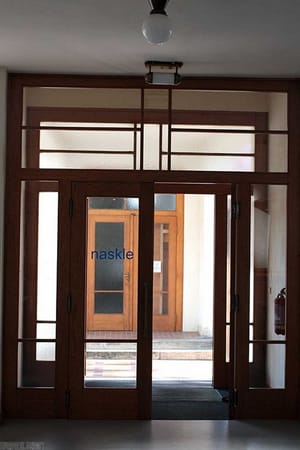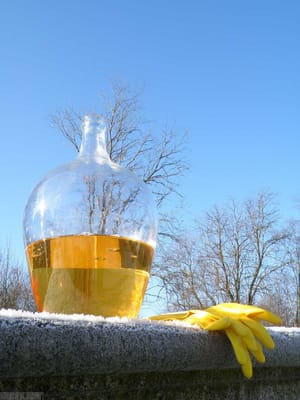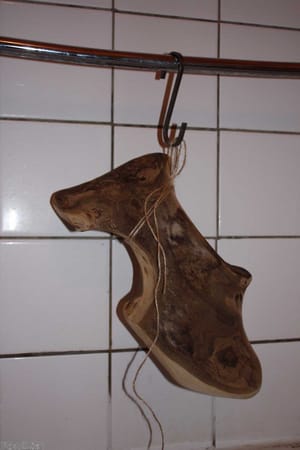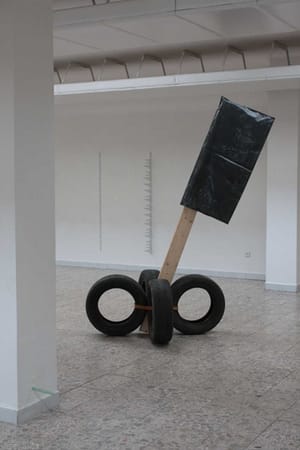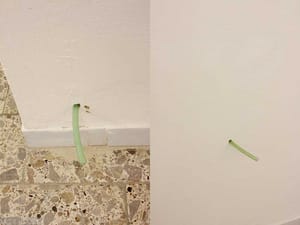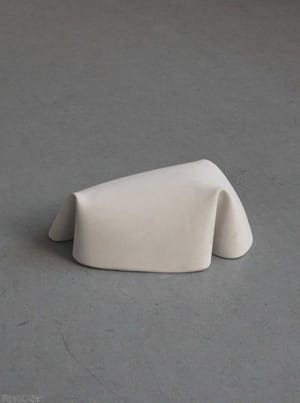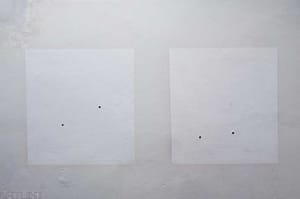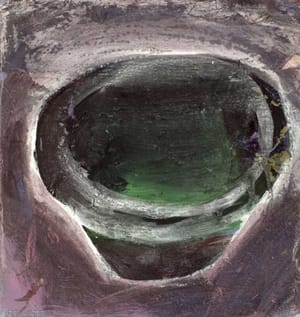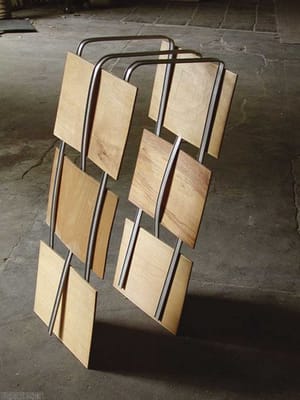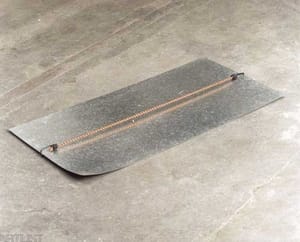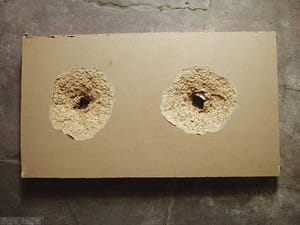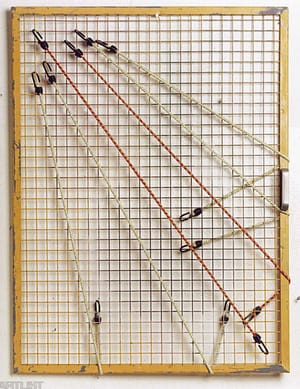- First Name
- Jan
- Surname
- Turner
- Born
- 1971
- Birth place
- Praha
- Place of work
- Praha
- Website
- www.janturner.info
- CSU Library
- ↳ Find in the catalogue
About artist
Jan Turner is primarily a sculptor and creator of installations. His projects work with and shift the imagination of everyday events and objects. By reinterpreting the function of objects and materials, he builds on conceptual art and post-minimalist sculpture. He tends to use traditional materials such as wood and metal, though he often works with readymade objects. Using these materials he creates an analogy to everyday objects, which then lose their function, though not their significance.
Another characteristic of Turner’s work is a subtle humour that operates on the level of materials and their properties. Dřevo stažené plastovými řemínky I a II / Wood Pulled with Plastic Straps I and II (2017) is one such example. Turner’s work is characterised by its simplicity and viewer-friendliness, without being superficial. Připravené náhrobky / Prepared Tombstones (2015) is an installation of abstract nameless tombstones made by Ytong. A brief glimpse of the installation reveals immediately what the objects are making reference to, though it is by no means clear what they represent. The theme of cheap materials and namelessness, along with how they are stacked and prepared for use, again embodies a subtle yet cynical humorous undertone pertaining to the absurdity of human existence. In addition, the installation was located in Galerie Na shledanou, which is part of a former crematorium. A similar attitude is to be found in the wooden installation Slon / Elephant (2017), in which the representation of the animal is restricted to tusks sticking out of the ground, which we may freely interpret as a sarcastic commentary upon the rapid disappearance of species in the Anthropocene.
The theme of the quotidian is again present in Židle / Chairs (2015), a series of acrylic paintings in which the repetitive painting of one motif from a single viewpoint offers a moment of both contemplation and caesura within the hustle and bustle of the contemporary world, as well as a certain nostalgia for the disappearance caused by the simplicity of depiction with its grey monochromicity.
A visually and conceptually more complex work is Hlas rodičů v zádech / Parents’ Voice in the Back (2015). The starting point of this work is a technique that Turner has been deploying for some time. This is a physiotherapeutic method involving glass jars with a circular opening being placed on parts of the body. Subsequently all the air is sucked out and the body, where waste products are to be found and the skin is inelastic, reacts by breaking blood vessels resulting in bruising. Photographs of different people who have undergone this procedure are both abstract and yet an embodied testimony of the problems they have encoded in the body. The artist himself says that these are “imprints of our bio-psycho-social identity”. He has long been interested in these techniques, and their use is another typical feature of his work, in which themes and forms are infused with his quotidian experience.
The work in which the spatial situation and abstract principle are transformed into a conceptual statement is Kolmice / Perpendicular, which was originally created for an exhibition on the theme of private nationalism. The installation comprises an iron rod and several chairs. The views of the seated spectators differs because the pole is perpendicular to the ground when viewed from the front but not when viewed from the side. This is a metaphor for the distorted vision of social relationships that leads, for instance, to nationalist tendencies. The situation evoked by Kolmice then allows for two readings of the work – either as a minimalist sculptural installation or the representation of social relationships.
Turner’s older work is characterised by the well-known subtle feature of Czech art, namely the use of cheap materials or readymades with an emphasis on the conceptual. Instead of proclaiming unambiguous themes, Turner attempts to work with the viewer’s everyday consciousness, which, when confronted by these works, is enriched by the possibilities of looking at things in a different way. One might say that after seeing Turner’s works we are able to create them in our imagination in our everyday lives. His works show that objects and the relationships between them offer themselves to be interpreted beyond their customary framework, and that the imagination can develop in immediate proximity, without the need for spectacular visuals or complex fictional worlds.
- Author of the annotation
- František Fekete
- Published
- 2018
CV
Studium:
1993–1999 AVU (Akademie výtvarných umění v Praze):
- intermediální škola, prof. Milan Knížák (1998–1999)
- škola experimentální grafiky, prof. Vladimír Kokolia (1995–1998)
- sochařská škola II, prof. Hugo Demartini (1993–1995)Praxe:
2012–2017
Psychoterapeutický výcvik SUR, ve skupinové terapii1993 – dosud
soukromá praxe Shiatsu a pomocné psychoterapie
Exhibitions
- Solo exhibitions
-
2021
Třetí prostor / Prostor Olga / Praha / k. Anetta Mona Chisa, Dita Lamačová, Veronika Holcová
Prolhané studánky / Nevan Contempo / Praha
2019
Péče o pahýl / Galerie 35m2 / Praha / k. Pavel Švec /
2018
Ubrus / Nau Gallery / Praha / k. Pavel Švec
Slon v oceánu / Galerie Divadla Minor / Praha
2016
Legendy Grafiky II / Galerie Havelka / Praha / k. prof. Vladimír Kokolia
Stojím na zdi / Nakladatelství TRIGON / Praha / k. Ivan Mečl
2015
Parent's voice in the back / Divus London / Londýn / k. Ivan Mečl
Hlas rodičů v zádech / Galerie Ferdinanda Baumana / Praha / k. Magdalena Hrubá
2013
Mistrovství života / Galerie Nashledanou / Volyně / k. Jan Freiberg
2012
Dvojdřez / s Alicí Nikitinovou / Galerie Chodovská tvrz / k. Jiří Ptáček
Vzdálená sestřenice, bílý bratranec / se Slávkou Sobotovičovou
MeetFaktory - Kostka / k. Jiří Ptáček
Nýt / galerie Jelení / Praha
2010
Banán naskle / s Alicí Nikitinovou / Galerie Blansko / k. Jiří Ptáček
You are komár / Ambrožův sbor / Hradec Králové /
2007
Vesnice / stánek 36 / výstaviště Olomouc / k. Lenka Vítková /
2006
Teď si nejhezčí / galerie Eskort / Brno / k. Jiří Ptáček /
2005
Jednota pramene / galerie Šternberk / k. Jiří Ptáček /
Souhlasný postoj / galerie ad astra / Kuřim / k. Jiří Ptáček /
Hubené léto / Galerie A.M. 180 / Praha
2003
Zdravotník se zraněním / Galerie N / Praha
- Group exhibitions not included in ARTLIST.
-
2023
výstava v rámci festivalu 4+4 dny v pohybu 2020 / Praha / k. Jiří Ptáček
Všechno je všech
2020
Všechno je jinak / výstava v rámci festivalu 4+4 dny v pohybu 2020 / Praha / k. 4+4 dny a Mikuláš Nevan
Baňkéř / performance pro Festival nahých forem 2020 / Praha / s Martin Zet / k. Lenka Klodová
JÁ / realizace pro Landscape festival 2020 / Praha / galerie Jaroslava Frágnera a 35m2
Co by se za dehet vešlo / s Petr Strouhal a Adam Štech / galerie SAM83 / Česká bříza / k. Jiří Ptáček
2019
Monolog kominíka ve městě bez komínů / galerie Nevan Contempo / Praha 3 /
k. Pavel Švec /
2018
Legendy Gr2 / Galerie ve věži Novoměstské radnice / Praha / k. Eva Červená, Vladimír Kokolia
Kdo je vítězem? / GVUO / Dům umění Ostrava / k. Yvona Ferencová
2017
DiStO (Divadlo statického objektu na PAF Olomouc 2017) /
k. Martin Piaček, Matěj Smetana, Jan Kralovic
9 SEM cor-ten Mezinárodní sochařské symposium, Bratislava 2017,
pořádá Kata Kissoczy, k. Daniela Kramerová
Humna help me / host na výstavě Tomáše Bambuška
Linhartova nadace / Letohradská 10 Praha 7
2016
Artsafari 31 / k. Daniela Kramerová/ Praha / Bubec
2014
Nestálá sbírka /k. Helena Blašková a Ivan Mečl/ Národní galerie Perla / Vrané n. Vltavou
2014
VII. nový zlínský salón / Zlín
Private nationalism - Domácí národovectví / k. Lenka Klodová, Ivan Mečl /
Divus Praha, Kunsthalle Košice, Pécz (Hungary)
2013
Lapidárium / k. Ateliér sochařství Vysoké školy uměleckoprůmyslové v Praze
2011
Štěstí / výstava současného umění pro bývalé Ústředí lidové umělecké výroby/
k. Denisa Václavová / Jan Freiberg /
VI. nový zlínský salón 2011 / Zlín
2010
My dva a čas / ÚLUV / Praha / k. Pavel Vančát /
2009
19 years after / vyslanectví ČR / Berlín / k. Milan Perič
Mémy Grafiky II / Wortnerův dům / České budějovice / k. Vladimír Kokolia, Šárka Trčková
2008
A kdy uprší ten druhej den / NOD / Praha / k. Jiří Havlíček /
Big Hybrid Gruppen Session Painting / Praha / k. Krištof Kintera a Denisa Václavová
Nic na odiv / Kateřinská zahrada / Praha / k. Vojtěch Míča
2007
Vylepšený model, kulhavý efekt / NoD / Praha / k. Dominik Lang /
2003
Konfrontace / Svárov / k. Milan Perič
2001
P / Galerie AVU /s Jaroslavem Valečkou / Praha
Diplomanti AVU / Karolinum / Praha
Machův šachový kroužek / galerie Vincence Kramáře / Praha
2000
Současná minulost / AJG / Hluboká nad Vltavou / k. Vlastimil Tetiva
1999
... / NOD / Praha / k. Krištov Kintera
1998
Skeleton&Peleton / Václavské náměstí 13/15 / Praha
Monography
- Monography
2014
katalog VII. nový zlínský salon
Noviny Galerie Nashledanou, rozhovor k výstavě
- Articles
Rádio:
Čajovna / rozhovor s Evou Melo / 2010
Televize:
artycok.tv/lang/cs-cz/26667/jan-turner
Artmix - talent měsíce února 2009
Artyčok, A kdy uprší ten druhej den / NOD / Jiří Havlíček / leden 2009Tisk:
2013
Lapidárium - recenze
Mistrovství života - Volyně - tisková zpráva
Mistrovství života - Volyně - recenze2012
katalog Galerie Nashledanou - doprovodné ilustrace
katalog k výstavě Dvojdřez s Alicí Nikitinovou2011
katalog - Šestý nový zlínský salon 2011
sborník CO14 2003-2005
Psí víno - č. 552003
Tomáš Vaněk / Pilování misky / rozhovor pro umělec 04/2003
Pesch Miroslav / Zdravotník se zraněním / Ateliér, srpen 2003



